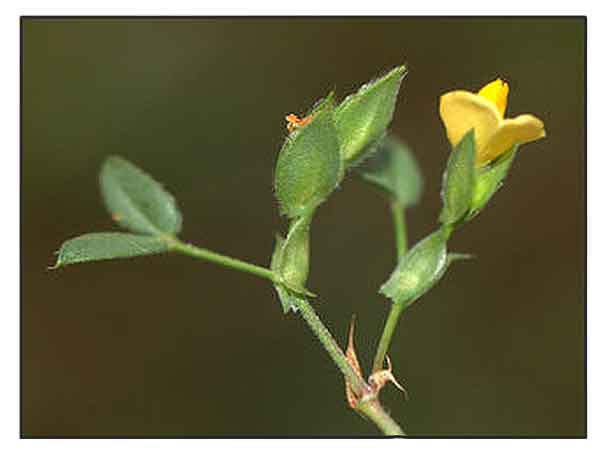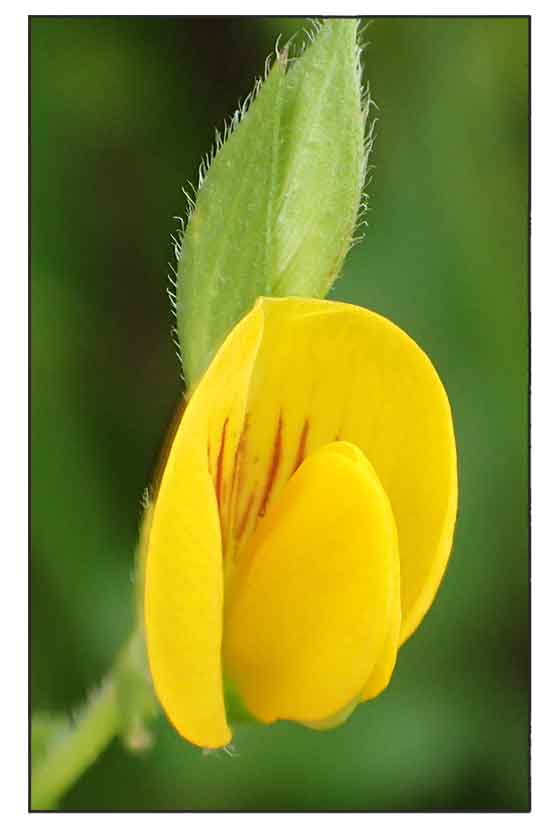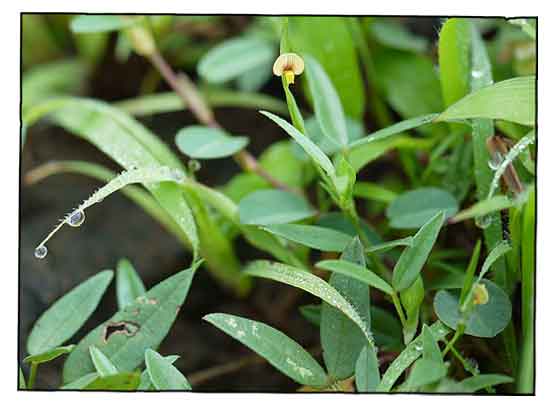 Gen info Gen info
- Zornia is a cosmopolitan genus of herbs from the legume family Fabaceae. It was recently assigned to the informal monophyletic Adesmia clade of Dalbergieae. (2)
Botany
• Annual, branches prostrate or ascending, glabrous or pubescent. Leaf bifoliolate, petiole 6.0-20 mm long, leaflets 0.7-3.0 cm long, 3.5-10 mm broad, sessile, lanceolate, linear-lanceolate or linear, glandular punctate below, glabrous. Inflorescence a 3-12-flowered raceme, 2.5-10 cm long. Bracts foliaceous, up to 1.3 cm long, black dotted, completely enclosing the flower. Calyx 3.5-4 mm long, 2 upper teeth obtuse, united, ciliate above, 2 lateral teeth smaller, the lowest longest, acute, ciliate. Corolla 7-8 mm long. Fruit 1-6 jointed, joints c. 2.5 mm long, indehiscent, echinate. (Flora of Pakistan)
 • Habit: Annual herb. Stem: Prostrate to suberect, up to 50 cm tall, branches prostrate or ascending, glabrous or pubescent. Leaves: Leaf bifoliolate, petiole 6.0-20 mm long; leaflets sessile, 0.7-3.0 cm long, 3.5-10 mm broad, lanceolate, linear-lanceolate or linear, glandular punctate below, glabrous. Flowers: Small in 3-12 flowered spicate racemes, 2.5 cm long. Peduncles slender. Bracts foliaceous, up to 1.3 cm long, black dotted, completely enclosing the flower and often the entire pod. Fruits: Pod 1-6 jointed, enclosed by the bracts or exerted, joints 2.5 mm long and wide, indehiscent, covered with short, straight, fulvous spines. Seeds: Ovoid to rounded in outline, seed surface smooth, olive, brown, or black. (4) • Habit: Annual herb. Stem: Prostrate to suberect, up to 50 cm tall, branches prostrate or ascending, glabrous or pubescent. Leaves: Leaf bifoliolate, petiole 6.0-20 mm long; leaflets sessile, 0.7-3.0 cm long, 3.5-10 mm broad, lanceolate, linear-lanceolate or linear, glandular punctate below, glabrous. Flowers: Small in 3-12 flowered spicate racemes, 2.5 cm long. Peduncles slender. Bracts foliaceous, up to 1.3 cm long, black dotted, completely enclosing the flower and often the entire pod. Fruits: Pod 1-6 jointed, enclosed by the bracts or exerted, joints 2.5 mm long and wide, indehiscent, covered with short, straight, fulvous spines. Seeds: Ovoid to rounded in outline, seed surface smooth, olive, brown, or black. (4)
Distribution
- Native to the Philippines.
- In Luzon: Bataan, Benguet. Cagayan, Ilocos Norte, NCR, Quezon, Rizal, Tarlac, Zambales
-
In open dry grasslands in the settled areas at low and medium elevation. (12)
- Also native to Andaman Is., Cambodia, China South-Central, China Southeast, East Himalaya, Hainan, India, Japan, Lesser Sunda Is., Mauritius, Myanmar, Nansei-shoto, Nepal, New Guinea, Pakistan, Réunion, Sri Lanka, Taiwan, Thailand, Vietnam, West Himalaya. (1)
Constituents
- Ethanolic extract revealed resins and reducing sugars, with absence of saponins.
- Computer study of powdered stem of Zornia gibbosa detected: Two types of cellulose group enzymes, 7 types of hemi-cellulose enzymes, 15 types of saccharides with glucosamine, 3 types of algenic acids, one xylans arbinoxylon (-D-xylopyranosyl unit), one pollytrans(ß-D-glucopyranasyl unit). Carbon, oxygen, nitrogen, and hydrogen were major constituents in 49.5%, 44.2%, 0.12%. AMD 6/3% respectively.
Ash, lignin, starch, and dihydroquercetin were found at 0.2%, 23.9%, 0.897%, and 0.653% respectively. (9)
Properties
- Considered astringent, anti-inflammatory.
-
Studies have suggested glucose lowering, anti-inflammatory, antioxidant, anthelmintic, analgesic properties.
Parts used
Leaves, roots, stems.
 Uses Uses
Edibility
- No reports on edibility.
Folkloric
- No reported folkloric medicinal use in the Philippines.
-
In India, the herb is traditionally used for inflammation and dysentery. The roots used as soporific in children. (5)
- In Karnataka folklore medicine, used for treatment of pain and inflammation. (8)
- In Ayurveda, thick paste of whole plant used externally for joint pains and fractures. (10)
- Tribes of Narmada District, South Gujarat, use
roots, stems and leaves of the plant for tremors, breathlessness, diarrhea, cancer, liver cirrhosis, dysentery, eye problems, diabetes, weight loss, kidney disease, polydipsia, heart diseases, etc. (11)
Others
- Agroforesty: Used as windbreak and for soil conservation.
Studies
• Glucose Lowering Effect: Study evaluated the antidiabetic activity of Zorbia gibbosa in an alloxan-induced diabetes in a rat model. A hydroalcoholic extract at 500 mg/kbw showed more glucose lowering activity compared with other extracts at different concentrations along with standard drug, glibenclamide. Acute toxicity testing of ethyl acetate and ethanol extracts as per OECD guidelines showed no mortality in administered doses of Z. gibbosa extracts. Extracts significantly (p≤0.01) restored physiologic changes that occurred with alloxan-induced diabetes. (3)
• Anti-Inflammatory / Aerial Parts: Study evaluated the anti-inflammatory activity of alcoholic extract of Z. gibbosa aerial parts using different models. In carrageenan induced rat paw edema, the alcoholic extract at doses of 500 and 750 mg/kbw showed % inhibition of paw volume at 3 hr. of 51.42 and 66.66, respectively (p<0.05). Lipoxygenase and interleukin-6 bioassays of extract showed significant and dose-dependent anti-inflammatory activity. (5)
• Antioxidant / Whole Plant: Study evaluated a 95% ethanol extract of whole plant powder for in-vitro scavenging activity using various methods viz. DPPH, ABTS radical scavenging, lipid peroxidation, iron chelation activity, superoxide scavenging, total antioxidant capacity and antioxidant hemoglobin glycosylation. Antioxidant activity estimated by IC50s showed: 14.78 µg/ml for lipid peroxidation, 40.29 µg/ml ABTS scavenging, 83.11 µg/ml for iron chelating activity, 105.90 µg/ml for DPPH scavenging, and 97.96 µg/ml for superoxide scavenging. Total antioxidant activity was 17.96 µg/ml. Hemoglobin glycosylation % scavenging was 45.49% and 74.68% at 0.5 and 1.0 mg/ml concentrations respectively. Results suggest significant antioxidant activity and concentration dependent scavenging of free radicals. (6)
• Anthelmintic / Leaves and Stems: Study evaluated leaves and stem extracts of Z. gibbosa for anthelmintic activity against Eisenia fetida earthworms using parameters of time to paralysis and death. Results showed significant dose dependent anthelmintic activity with rapid onset of paralysis and mortality. Results suggest a source of natural anthelmintic agent. (7)
• Analgesic: Study evaluated the analgesic activity of Zornia gibbosa using Eddy's hotplate method. The test drug was administered in the form of freshly prepared Phant kalpana (hot infusion). There was gradual and statistically significant increase in reaction time suggest peak latency period of 150 min. Results suggest significant analgesic activity (p=0.035) by hot plate method and possible role of opioid receptors for analgesic action. (8)
Availability
- Wild-crafted.
- Herbal products, raw dried grass in the cybermarket. (Alibaba)
|

![]()




 • Habit: Annual herb. Stem: Prostrate to suberect, up to 50 cm tall, branches prostrate or ascending, glabrous or pubescent. Leaves: Leaf bifoliolate, petiole 6.0-20 mm long; leaflets sessile, 0.7-3.0 cm long, 3.5-10 mm broad, lanceolate, linear-lanceolate or linear, glandular punctate below, glabrous. Flowers: Small in 3-12 flowered spicate racemes, 2.5 cm long. Peduncles slender. Bracts foliaceous, up to 1.3 cm long, black dotted, completely enclosing the flower and often the entire pod. Fruits: Pod 1-6 jointed, enclosed by the bracts or exerted, joints 2.5 mm long and wide, indehiscent, covered with short, straight, fulvous spines. Seeds: Ovoid to rounded in outline, seed surface smooth, olive, brown, or black. (
• Habit: Annual herb. Stem: Prostrate to suberect, up to 50 cm tall, branches prostrate or ascending, glabrous or pubescent. Leaves: Leaf bifoliolate, petiole 6.0-20 mm long; leaflets sessile, 0.7-3.0 cm long, 3.5-10 mm broad, lanceolate, linear-lanceolate or linear, glandular punctate below, glabrous. Flowers: Small in 3-12 flowered spicate racemes, 2.5 cm long. Peduncles slender. Bracts foliaceous, up to 1.3 cm long, black dotted, completely enclosing the flower and often the entire pod. Fruits: Pod 1-6 jointed, enclosed by the bracts or exerted, joints 2.5 mm long and wide, indehiscent, covered with short, straight, fulvous spines. Seeds: Ovoid to rounded in outline, seed surface smooth, olive, brown, or black. (
